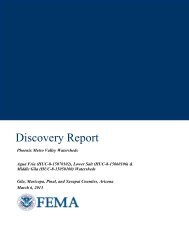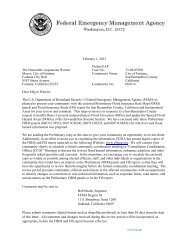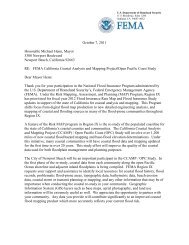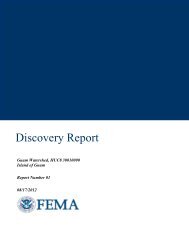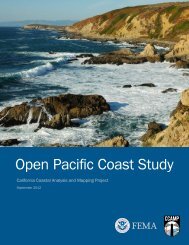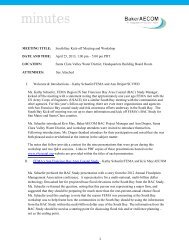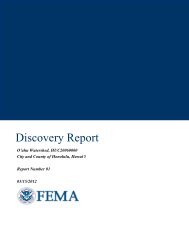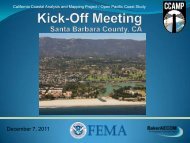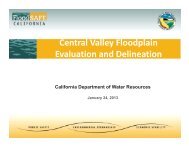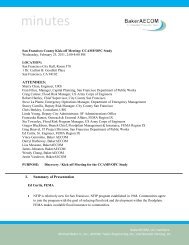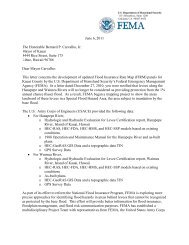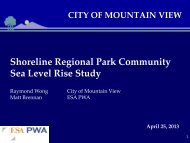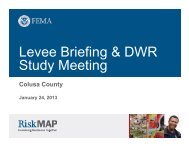YAVAPAI COUNTY, ARIZONA Federal Emergency ... - FEMA Region 9
YAVAPAI COUNTY, ARIZONA Federal Emergency ... - FEMA Region 9
YAVAPAI COUNTY, ARIZONA Federal Emergency ... - FEMA Region 9
Create successful ePaper yourself
Turn your PDF publications into a flip-book with our unique Google optimized e-Paper software.
The Verde Lakes Estates in the Town of Camp Verde experienced severe flooding<br />
from West Clear Creek in September 1970, December 1971, October 1972,<br />
February 1976, and February 1980 (Sellers, W.D., Hill, R.H., and Sanderson-<br />
Raw, M., 1986; USACE, 1975; <strong>FEMA</strong>, 1985, Preliminary 1991). The peak<br />
discharges are shown in Table 4. The 1980 flood was so severe that channel<br />
alignment and grade were significantly altered. This alteration occurred after the<br />
mapping used for the 1985 Flood Insurance Study was completed in 1978<br />
(<strong>FEMA</strong>, 1985, Preliminary 1991).<br />
Historic peak discharges at the USGS West Clear Creek gaging station, near the<br />
Town of Camp Verde, are shown chronologically for the seven historic ranked<br />
annual discharges in 23 years of record (see Table 4).<br />
No significant flood-related losses, either in lives or property, have been recorded<br />
since the Town of Chino Valley was founded in 1971. The heaviest rainfall of the<br />
year usually occurs between July and September, but there are also secondary<br />
storms that come in from the Pacific Coast during the later winter months. The<br />
winter snows dissipate rapidly due to the dry air. Both thunderstorms and rapid<br />
snowmelt conditions are potential flood problems. The Town of Chino Valley is<br />
subject to hazards produced by rainfall in the nearby City of Prescott.<br />
Historic records of major floodflow events in the Town of Clarkdale area indicate<br />
that many of these flows have resulted in relatively little damage to property.<br />
Historic floodflow events recorded on the Verde River are shown in Table 4. The<br />
discharge values have return periods between 10- and 2-percent annual chance<br />
events as determined from gage records (1916 through 1920 and 1966 through<br />
1979) compiled by the USGS and subsequent log-Pearson Type III analysis. The<br />
February 21, 1920, event is the maximum flood of record and has an estimated<br />
recurrence interval of a 2-percent annual chance flood event. The February 7,<br />
1980, flood event had a 20-year recurrence interval.<br />
Historical records of major floodflow events in the City of Cottonwood area<br />
indicate that many of these flows resulted in relatively little damage to property<br />
and were mostly inconvenient in nature. The extensive development in the City of<br />
Cottonwood which has occurred since these events increases the likelihood that<br />
the resulting property damage would be much more significant. Significant<br />
flooding problems have occurred as a result of high magnitude floodflows on Del<br />
Monte Wash. This problem has occurred as a result of floodwaters breaking out of<br />
the channel at the East Main Street crossing and flowing downstream on the<br />
adjacent overbanks through the most highly developed portion of the City of<br />
Cottonwood. This breakout resulted from insufficient culvert capacity beneath the<br />
East Main Street crossing and from debris blockage of the culverts. On<br />
August 26, 1964, a high intensity rainfall event occurred over the Del Monte<br />
Wash drainage basin and resulted in a relatively large magnitude flood event. An<br />
excerpt from the "Verde Independent" on September 3, 1964, stated, "...this storm<br />
of August 26, alone dumped more than the 8-year average of 2.18 inches, falling<br />
in a 2-hour period. The day before the big storm 0.88 inch was reported in<br />
Cottonwood." The 2.18-inch rainfall in a 2-hour period translates to<br />
18




